Solar panels for summer cottages and houses: types, principle of operation and calculation procedure for solar systems
Science has given us a time when the technology of using solar energy has become publicly available. Every owner has the opportunity to get solar panels for the house. Summer residents are not far behind in this matter. More often they are far from centralized sources of sustainable power supply.
We suggest that you familiarize yourself with the information representing the device, the principles of operation and calculation of the working components of the solar system. Familiarization with the information we have proposed will approximate the reality of providing your site with natural electricity.
For a clear perception of the provided data, detailed diagrams, illustrations, photo and video instructions are attached.
The content of the article:
- The device and principle of operation of the solar battery
- Types of Solar Panel Modules
- Scheme of work of solar power supply
- Peak load and daily average power consumption
- The procedure for calculating energy indicators
- Selection of nodes of solar power plants
- Assembly of a household solar system
- Conclusions and useful video on the topic
The device and principle of operation of the solar battery
Once inquisitive minds opened for us natural substances that are produced under the influence of particles of light from the sun, photons, electrical energy. The process was called the photoelectric effect. Scientists have learned to control the microphysical phenomenon.
Based on semiconductor materials, they created compact electronic devices - photocells.
Manufacturers have mastered the technology of combining miniature converters into efficient solar panels. Efficiency of panel solar modules made of silicon widely produced by the industry is 18-22%.
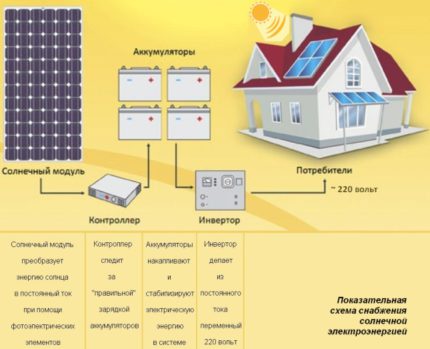
A solar battery is assembled from the modules. It is the final destination of photons from the Sun to the Earth.From here, these components of light radiation continue their path already inside the electric circuit as DC particles.
They are distributed by batteries, or are transformed into charges of an alternating electric current of 220 volts, supplying all kinds of home technical devices.
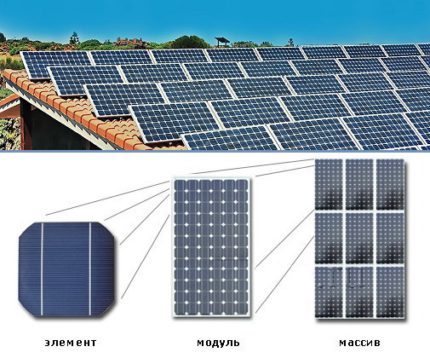
You will find more details about the specifics of the device and the principle of operation of the solar battery in another popular article our site.
Types of Solar Panel Modules
Solar panels-modules are assembled from solar cells, otherwise - photoelectric converters. PECs of two types have found widespread use.
They differ in the types of silicon semiconductor used for their manufacture, these are:
- Polycrystalline. These are solar cells made from silicon melt by long-term cooling. A simple production method determines the affordability of the price, but the performance of the polycrystalline option does not exceed 12%.
- Monocrystalline. These are the elements obtained by cutting thin plates of an artificially grown silicon crystal. The most productive and expensive option. The average efficiency in the region of 17%, you can find single-crystal photocells with higher performance.
Polycrystalline solar cells of a flat square shape with an inhomogeneous surface. Monocrystalline varieties look like thin, homogeneous surface structure squares with cut corners (pseudo-squares).
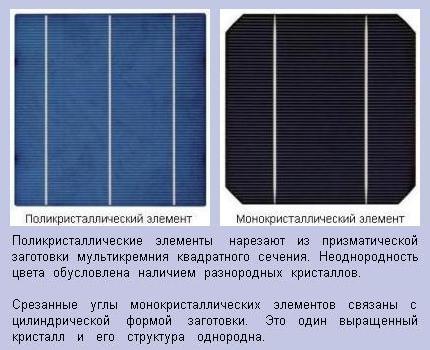
The panels of the first version with the same power are larger than the second because of the lower efficiency (18% versus 22%). But interest, on average, is ten cheaper and in predominant demand.
About the rules and nuances of choosing solar panels for supplying energy to autonomous heating, you can read here.
Scheme of work of solar power supply
When you glance at the mysteriously sounding names of the nodes that make up the solar power supply system, the idea comes to the super-technical complexity of the device.
At the micro level of the photon's life, this is so. And clearly the general circuit of the electric circuit and the principle of its action look very simple. From the luminary of heaven to the “lamp of Ilyich” there are only four steps.
Solar modules are the first component of a power plant. These are thin rectangular panels assembled from a certain number of standard photocell plates. Manufacturers make photo panels different in electrical power and voltage, a multiple of 12 volts.
Flat-shaped devices are conveniently located on surfaces exposed to direct rays. Modular units are combined by interconnecting the solar battery. The task of the battery is to convert the received energy of the sun, producing a constant current of a given value.
Electric Charge Storage Devices - batteries for solar panels known to all. Their role inside the energy supply system from the sun is traditional. When home consumers are connected to a centralized network, energy stores are stored in electricity.
They also accumulate its excess, if the current of the solar module is sufficient to provide the power consumed by electrical appliances.
The battery pack gives the circuit the required amount of energy and maintains a stable voltage as soon as its consumption rises to an increased value. The same thing happens, for example, at night with idle photo panels or during light sunny weather.

The controller is an electronic intermediary between the solar module and the batteries. Its role is to regulate the battery level. The device does not allow their boiling from recharging or falling electric potential below a certain norm, necessary for the stable operation of the entire solar system.
Flip, the sound of the term is so literally explained solar inverter. Yes, because in fact, this unit performs a function that once seemed to fiction to electrical engineers.
It converts the direct current of the solar module and batteries into alternating current with a potential difference of 220 volts. It is this voltage that is working for the vast majority of household electrical appliances.

Peak load and daily average power consumption
The pleasure to have your own solar station is still a lot. The first step on the path to possessing the power of solar energy is to determine the optimal peak load in kilowatts and the rational average daily energy consumption in kilowatt hours of a home or summer cottage.
The peak load is created by the need to turn on several electrical devices at once and is determined by their maximum total power, taking into account the overstated starting characteristics of some of them.
Calculation of the maximum power consumption allows you to identify the vital need for the simultaneous operation of which electrical appliances, and which are not very. This indicator obeys the power characteristics of the nodes of the power plant, that is, the total cost of the device.
The daily energy consumption of an electrical appliance is measured by the product of its individual power for the time that it worked from the network (consumed electricity) for a day. The total average daily energy consumption is calculated as the sum of the consumed energy of electricity by each consumer for the daily period.
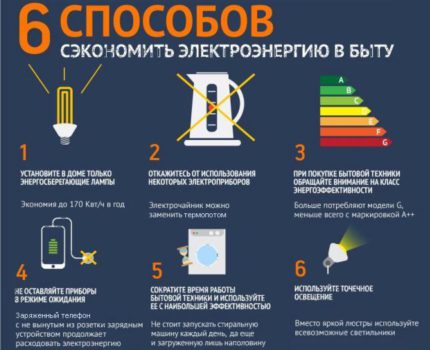
The result of energy consumption helps to rationalize the consumption of solar electricity. The result of the calculations is important for the further calculation of the battery capacity. From this parameter, the price of the battery pack, a lot of a worthwhile component of the system, depends even more.
The procedure for calculating energy indicators
The process of calculations literally begins with a horizontally arranged, in a cell, expanded notebook sheet. With light pencil lines from a sheet you get a form with thirty counts, and lines by the number of home appliances.
Preparation for arithmetic calculations
The first column is drawn traditional - serial number. The second column is the name of the appliance. The third is its individual power consumption.
Columns from the fourth to the twenty-seventh are the hours of the day from 00 to 24. The following are entered in them through the horizontal fractional line:
- in the numerator - the operating time of the device in the period of a particular hour in decimal form (0,0);
- the denominator is again its individual power consumption (this repetition is needed to calculate hourly loads).
The twenty-eighth column is the total time that the household appliance works during the day. At the twenty-ninth, the personal energy consumption of the device is recorded as a result of multiplying the individual power consumption by the operating time for the daily period.

The thirtieth column is also standard - note. It is useful for intermediate calculations.
Consumer specification
The next stage of calculations is the transformation of a notebook form into a specification of household electricity consumers. The first column is clear. Here are the line numbers.
The second column contains the names of energy consumers. It is recommended to start filling up the entrance hall with electrical appliances. The following describes other rooms counterclockwise or clockwise (as you wish).
If there is a second (etc.) floor, the procedure is the same: from the stairs - roundabout. At the same time, one should not forget about staircase devices and street lighting.
It is better to fill the third column with the power opposite the name of each electric device along the way with the second.
Columns four through twenty-seven correspond to their every hour of the day. For convenience, they can immediately be crossed out with horizontal lines in the middle of the lines. The resulting upper halves of the lines are like numerators, the lower halves are denominators.
These columns are filled line by line. Numerators are selectively formatted as time intervals of the decimal format (0,0), reflecting the operating time of a given electrical appliance in a particular hourly period. In parallel with the numerators, denominators are entered with the power indicator of the device taken from the third column.
After all the hourly columns are full, they proceed to counting the individual daily working time of electrical appliances, moving along the lines.The results are recorded in the corresponding cells of the twenty-eighth column.

Based on the power and working time, the daily energy consumption of all consumers is sequentially calculated. It is noted in the cells of the twenty-ninth column.
When all the lines and columns of the specification are filled, they calculate the totals. Adding the graphic power from the denominators of the hourly columns, the loads of each hour are obtained. Summing up the individual daily energy consumption of the twenty-ninth column from top to bottom, they find the total daily average.
The calculation does not include the future system’s own consumption. This factor is taken into account by an auxiliary coefficient in subsequent final calculations.
Analysis and optimization of the data
If solar power is planned as a backup, data on hourly power consumption and overall average daily energy consumption help minimize the consumption of expensive solar electricity.
This is achieved by eliminating energy-intensive consumers from use until the restoration of centralized power supply, especially during peak hours.
If the solar power system is designed as a source of constant power supply, then the results of hourly loads are pushed forward. It is important to distribute electricity consumption during the day in such a way as to remove the much more prevailing highs and the very failing lows.
The exception of peak, equalization of maximum loads, elimination of sharp dips in energy consumption over time allows you to choose the most economical options for nodes of the solar system and provide stable, most important, trouble-free long-term operation of the solar station.
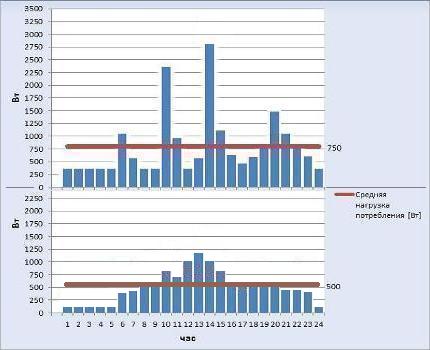
The presented drawing shows the transformation obtained on the basis of the compiled specifications of an irrational schedule in optimal. The indicator of daily consumption was reduced from 18 to 12 kW / h, the average hourly load from 750 to 500 watts.
The same principle of optimality is useful when using the option of power from the sun as a backup. It is unnecessary to spend money on increasing the power of solar modules and batteries for the sake of some temporary inconvenience.
Selection of nodes of solar power plants
To simplify the calculations, we will consider the version of the use of a solar battery as the main source for supplying electric energy. The consumer will be a conditional country house in the Ryazan region, where they constantly reside from March to September.
Practical calculations based on the data of the rational hourly energy consumption schedule published above will give clarity to the reasoning:
- Total average daily power consumption = 12,000 watts / hour.
- Average load consumption = 500 watts.
- Maximum load 1200 watts.
- Peak load 1200 x 1.25 = 1500 watts (+ 25%).
The values will be required in the calculations of the total capacity of solar devices and other operating parameters.
Determination of the operating voltage of the solar system
The internal operating voltage of any solar system is based on a multiplicity of 12 volts, as the most common battery rating. The most widely nodes of solar stations: solar modules, controllers, inverters - are produced under the popular voltage of 12, 24, 48 volts.
Higher voltage allows the use of smaller supply wires - and this is increased contact reliability. On the other hand, defective 12V network batteries can be replaced one at a time.
In a 24-volt network, considering the specifics of battery operation, it will be necessary to replace only pairs. A 48V network will require changing all four batteries of the same branch. In addition, at 48 volts there is already a danger of electric shock.
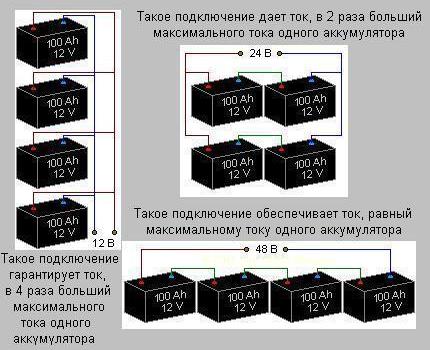
The main choice of the nominal value of the internal potential difference of the system is connected with the power characteristics of inverters produced by modern industry and should take into account the peak load:
- from 3 to 6 kW - 48 volts,
- from 1.5 to 3 kW - equal to 24 or 48V,
- up to 1.5 kW - 12, 24, 48V.
Choosing between the reliability of the wiring and the inconvenience of replacing the batteries, for our example we will focus on reliability. In the future, we will build on the operating voltage of the calculated system 24 volts.
Battery Pack Solar Modules
The formula for calculating the power required from a solar battery looks like this:
Rcm = (1000 * Yesut) / (k * Sin),
Where:
- Rcm = power of the solar battery = total power of solar modules (panels, W),
- 1000 = accepted photosensitivity of photoelectric converters (kW / m²)
- Eat = the need for daily energy consumption (kW * h, in our example = 18),
- k = seasonal coefficient taking into account all losses (summer = 0.7; winter = 0.5),
- Sin = tabular value of insolation (solar radiation flux) with optimal panel tilt (kW * h / m²).
You can find out the value of insolation from the regional meteorological service.
The optimal angle of inclination of solar panels is equal to the latitude of the area:
- in spring and autumn,
- plus 15 degrees - in the winter,
- minus 15 degrees in the summer.
The Ryazan region considered in our example is located at 55th latitude.

For the time taken from March to September, the best unregulated tilt of the solar battery is equal to the summer angle of 40⁰ to the surface of the earth. With this installation of modules, the average daily insolation of Ryazan during this period is 4.73. All the numbers are there, let's do the calculation:
Pcm = 1000 * 12 / (0.7 * 4.73) ≈ 3 600 watts.
If we take 100-watt modules as the basis of the solar battery, then 36 of them will be required. They will weigh 300 kilograms and occupy an area of about 5 x 5 m in size.
Field-proven wiring diagrams and options for connecting solar panels given here.
Arrangement of battery power unit
When choosing batteries, you need to be guided by the postulates:
- Conventional car batteries are NOT suitable for this purpose. Solar power batteries are labeled “SOLAR”.
- Acquire batteries should only be identical in all respects, preferably from one factory batch.
- The room where the battery pack is located should be warm. The optimum temperature when the batteries give out full power = 25⁰C. When it decreases to -5⁰C, the battery capacity decreases by 50%.
If we take an exponential battery with a voltage of 12 volts and a capacity of 100 amperes / hour for calculation, it is not difficult to calculate, for an entire hour it will be able to provide consumers with a total power of 1200 watts. But this is with complete discharge, which is extremely undesirable.
For long battery life, it is NOT recommended to reduce their charge below 70%. Limit figure = 50%. Taking 60% as the middle ground, we put the energy reserve of 720 W / h for every 100 A * h of the capacitive component of the battery (1200 W / h x 60%) as the basis for subsequent calculations.
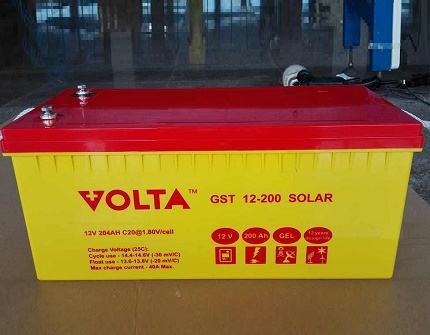
Initially, batteries must be installed 100% charged from a stationary current source. Batteries must completely cover the load of the dark. If you are not lucky with the weather, maintain the necessary system parameters during the day.
It is important to consider that an overabundance of batteries will lead to their constant undercharging. This will significantly reduce the service life. The most rational solution is to equip the unit with batteries with an energy reserve sufficient to cover one daily energy consumption.
To find out the required total battery capacity, we divide the total daily energy consumption of 12,000 W / h by 720 W / h and multiply by 100 A * h:
12 000/720 * 100 = 2500 A * h ≈ 1600 A * h
Total for our example, we need 16 batteries with a capacity of 100 or 8 at 200 Ah *, connected in series-parallel.
Choosing a good controller
Competent selection battery charge controller (Battery) - a very specific task. Its input parameters should correspond to the selected solar modules, and the output voltage should correspond to the internal potential difference of the solar system (in our example, 24 volts).
A good controller must ensure:
- A multistage battery charge that extends their effective life by a multiple.
- Automatic mutual, battery and solar battery, connection-disconnection in correlation with charge-discharge.
- Reconnecting the load from the battery to the solar battery and vice versa.
This small knot is a very important component.
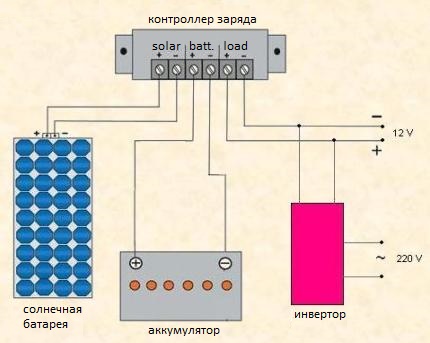
The correct choice of the controller depends on the trouble-free operation of the expensive battery pack and the balance of the entire system.
Selection of the best inverter
The inverter is selected so that it can provide a long-term peak load. Its input voltage must correspond to the internal potential difference of the solar system.
For the best selection, it is recommended to pay attention to the parameters:
- The shape and frequency of the generated alternating current. The more close to a 50 Hz sine wave, the better.
- Device efficiency. The higher 90% - the more wonderful.
- Own consumption of the device. Must be commensurate with the overall power consumption of the system. Ideally - up to 1%.
- The ability of the unit to withstand short-term double overloads.
The most distinctive design is an inverter with a built-in controller function.
Assembly of a household solar system
We made you a photo selection that clearly demonstrates the process of assembling a household solar system from modules manufactured at the factory:
Conclusions and useful video on the topic
Clip # 1. DIY installation of solar panels on the roof of a house:
Clip # 2. The choice of batteries for the solar system, types, differences:
Clip # 3. Country solar power station for those who do everything themselves:
The considered step-by-step calculation methods, the basic principle of the effective operation of a modern solar panel battery as part of a home autonomous solar station will help the owners of a large house in a densely populated area and a country house in the wilderness to gain energy sovereignty.
Do you want to share the personal experience that you gained during the construction of a mini solar system or just batteries? Do you have any questions that you would like to receive an answer for, found any flaws in the text? Please leave comments in the block below.

 Solar panels for heating a house: types, how to choose and install them correctly
Solar panels for heating a house: types, how to choose and install them correctly 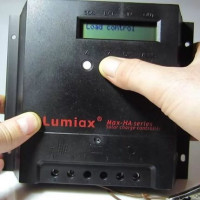 Solar charge controller: circuit, principle of operation, connection methods
Solar charge controller: circuit, principle of operation, connection methods  The principle of operation of the solar battery: how the solar panel is arranged and works
The principle of operation of the solar battery: how the solar panel is arranged and works  Solar heating systems: analysis of heating technology based on solar systems
Solar heating systems: analysis of heating technology based on solar systems 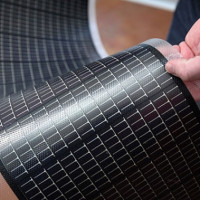 Flexible solar panels: an overview of typical designs, their characteristics and connection features
Flexible solar panels: an overview of typical designs, their characteristics and connection features 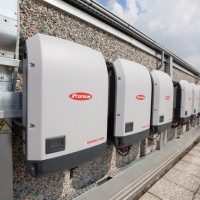 Inverter for solar panels: types of devices, model overview, connection features
Inverter for solar panels: types of devices, model overview, connection features  How much does it cost to connect gas to a private house: the price of organizing gas supply
How much does it cost to connect gas to a private house: the price of organizing gas supply  The best washing machines with dryer: model rating and customer tips
The best washing machines with dryer: model rating and customer tips  What is the color temperature of light and the nuances of choosing the temperature of the lamps to suit your needs
What is the color temperature of light and the nuances of choosing the temperature of the lamps to suit your needs  Replacement of a geyser in an apartment: replacement paperwork + basic norms and requirements
Replacement of a geyser in an apartment: replacement paperwork + basic norms and requirements
The cottage is near Krasnodar. There are enough sunny days, so I decided to experiment and put solar panels. I bought polycrystalline. But at first I made a mistake, I did the wrong calculation of the number of solar panels, so in June the effect was zero from them. A couple of weeks ago I added more panels, and there is already an effect. Although in general it turned out a little expensive. I think it will gradually pay off.
Very informative. It seems to me that questions about the cost of the solar system itself, the cost of installation and operation, and as a result, the payback period are modestly circumvented. For example, if the system pays off within 15-20 years, is it worth it to fence the garden? During this time, it itself will deteriorate or become obsolete morally. Maybe if there is no centralized power supply, just use a generator?
Everything is great! And what do you advise to put in a small cottage? To heat tea, to connect a lawn-mower? There is no desire to conclude an agreement with the power system - these are monopolists.
I will answer two questions at once: yours and the payback of the system itself. Firstly, in latitudes where there are many sunny days - there the solar system will pay off faster than, for example, in Siberia. I know that in the south of Russia the minimum payback period is three years.
Further, a relatively simple installation in the country to feed the most necessary equipment: there are ready-made solutions, moreover, inexpensive, about 350-400 dollars. For example, AXIOMA energy with an indicator of 22 / 7kW * h per month, summer / winter, to make it clearer. Such a system is quite enough to drink tea, charge the phone and connect the lawn mower.
I'm going to buy a house in the village, and there they often turn off the electricity. I want to protect myself, and this topic is just very interesting.
How much does it cost to fully supply 100 m2 of house electricity? Can using solar panels provide 100% autonomy?
Well, the most important question, but how will this whole construction lead in the winter? And then you look, they just put everything on the roof and everything, for sure, the snow sticks, and in the spring everything starts to thaw. In general, all this will pay off in theory and what is the average life?
In general, there are those who use a couple of years at least? It would be interesting to hear their opinion.
You have quite difficult questions, but I will try to answer them in order.
Regarding the cost of maintaining a house of 100 m2. Here it is not a matter of area but nominal energy consumption. Do you plan to heat the house like? Gas, solid fuel or electric boiler, electric convectors? If on electrics, then in winter it is unlikely that the system will pull. Look, a solar station per kWh will cost $ 10 thousand. In December there will be the lowest minimum monthly electricity generation up to 429 kW * h, the maximum in July - up to 2 142 kW * h. With these indicators, you can ensure autonomy in providing your home with electricity.
At the expense of winter and autumn. When nature “rages”, it will be necessary to clean the solar panels from fallen leaves and snow so that productivity does not decrease.
At the expense of payback and terms of operation. If you sell surplus to the state during peak months, then you can get a payback period of 5 years, approximately. This is not a specific figure, it should be calculated according to your consumption per month, sunny days, current tariffs, etc. Warranties on solar panels are now at least ten years old, and their degradation rate is only 0.7% per year.